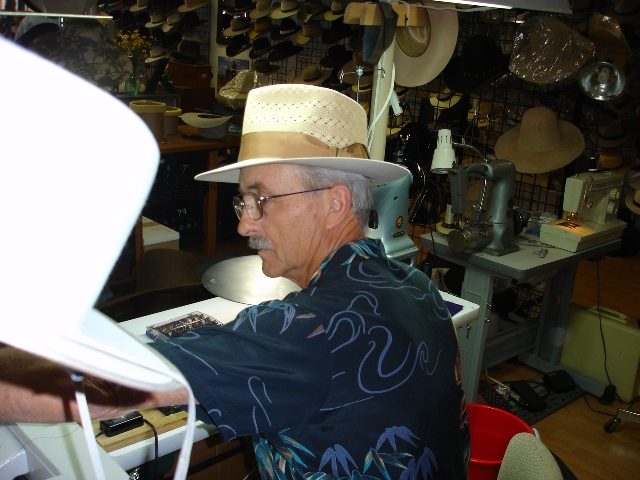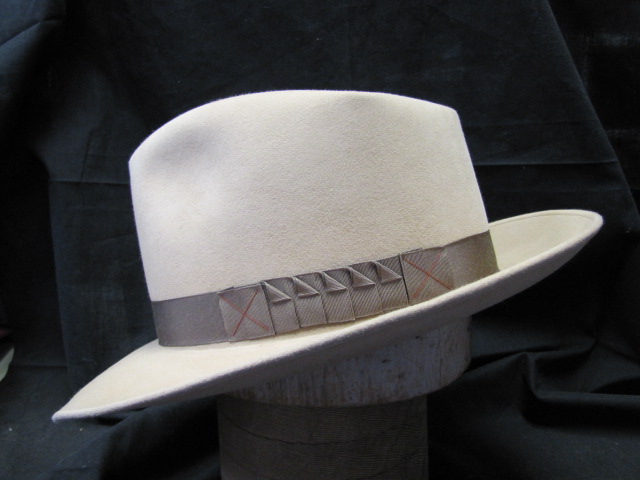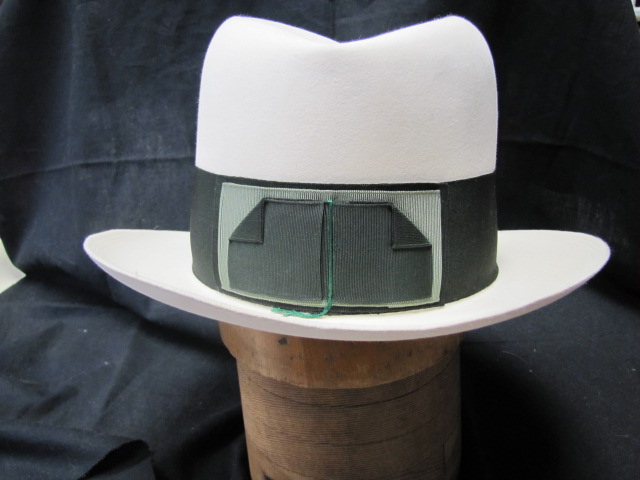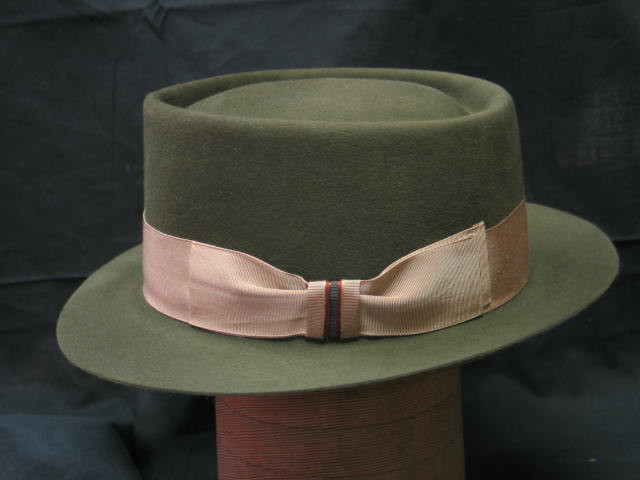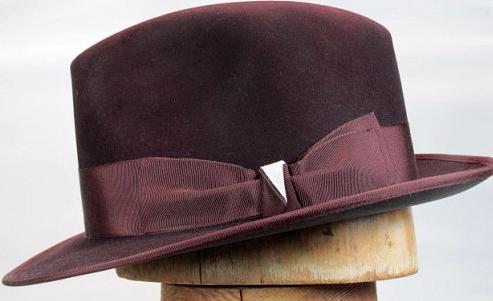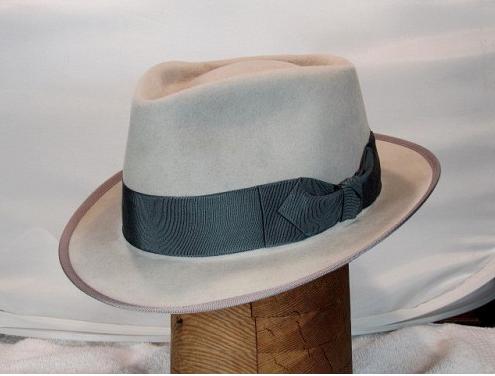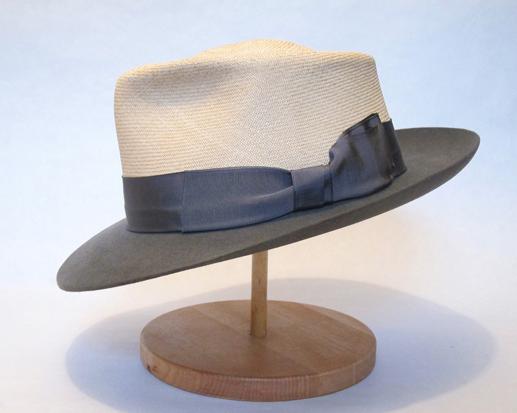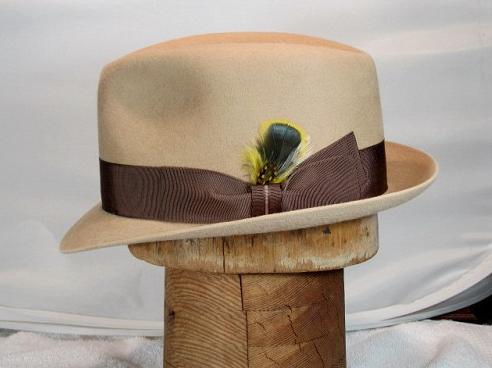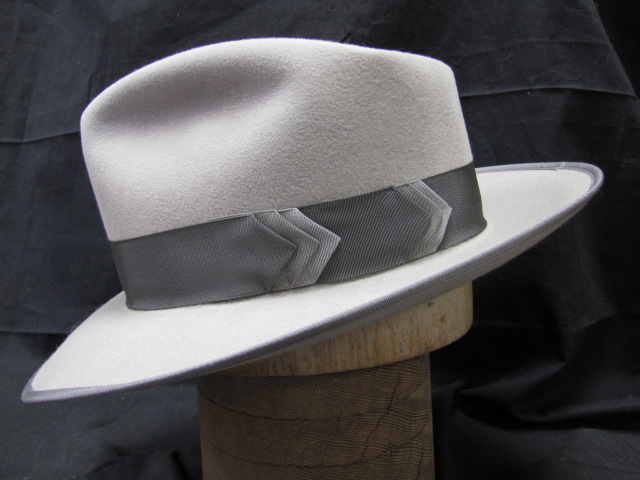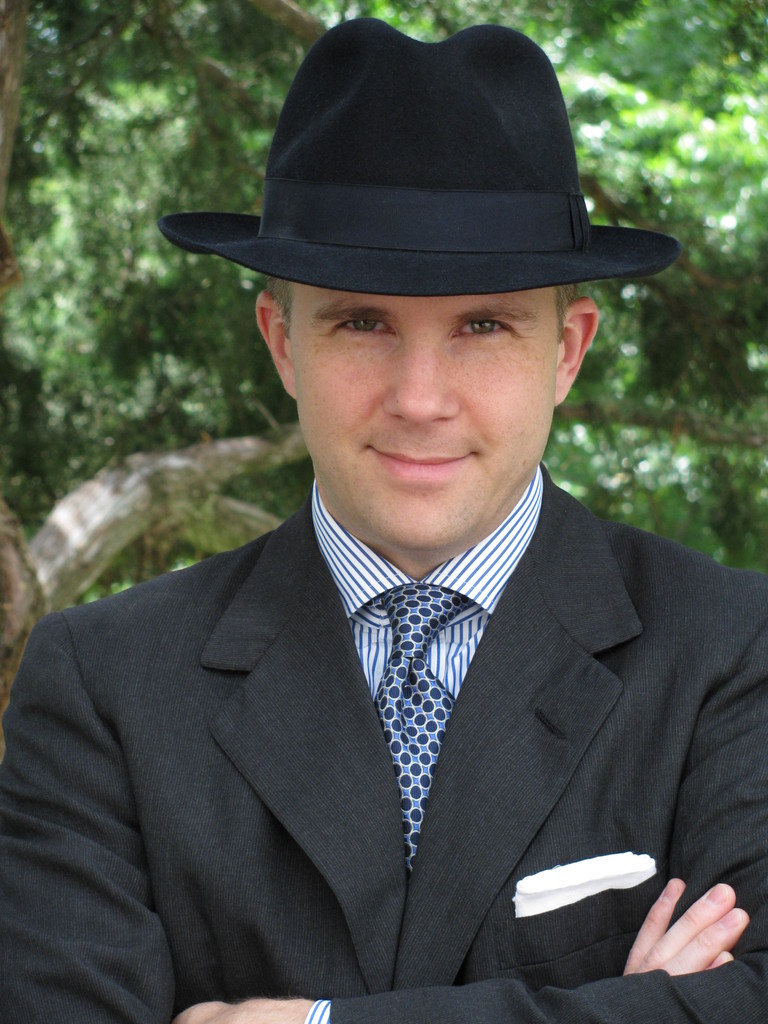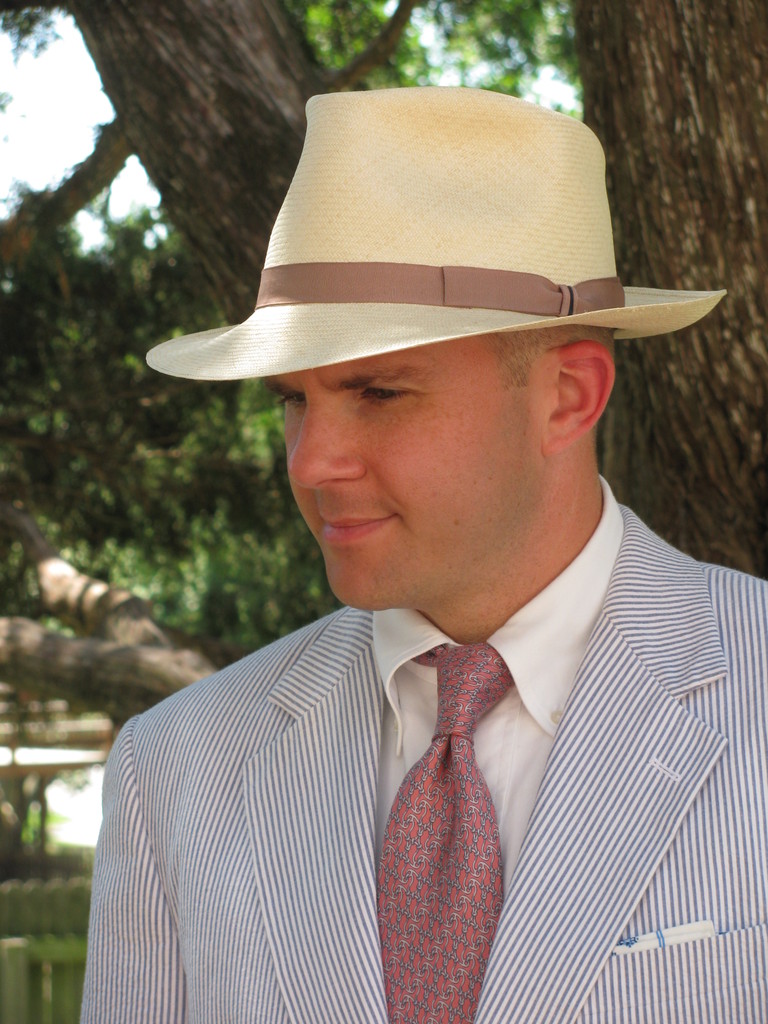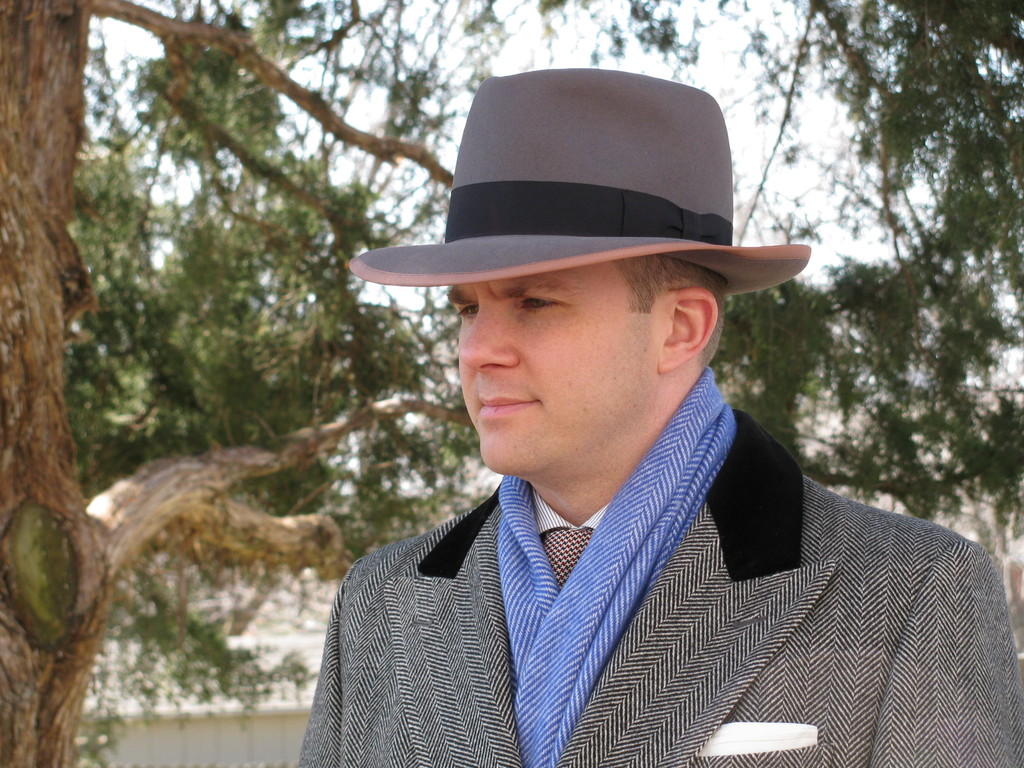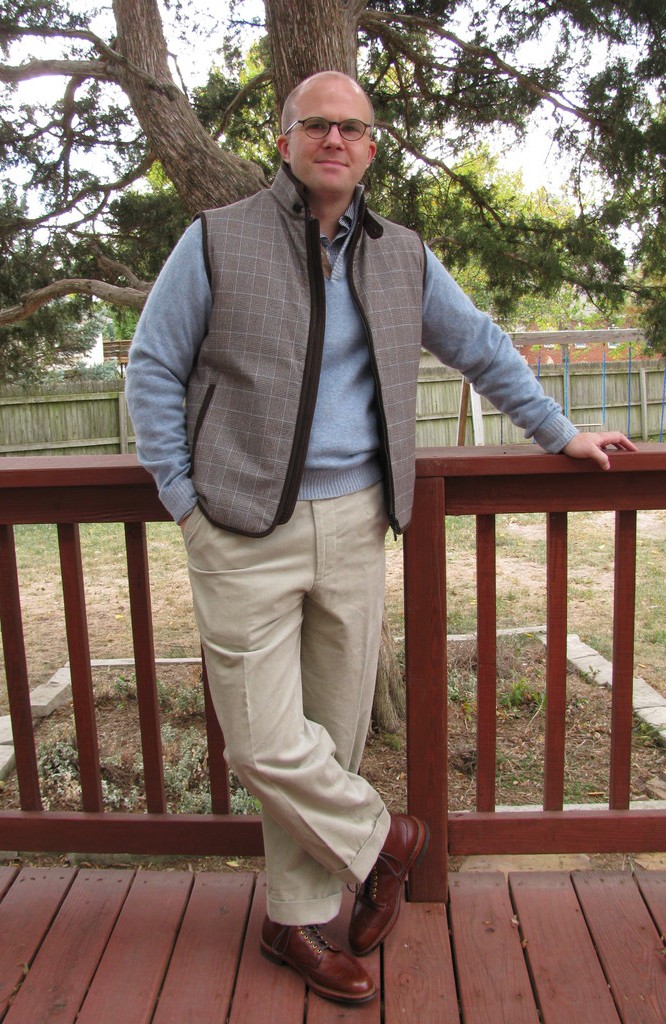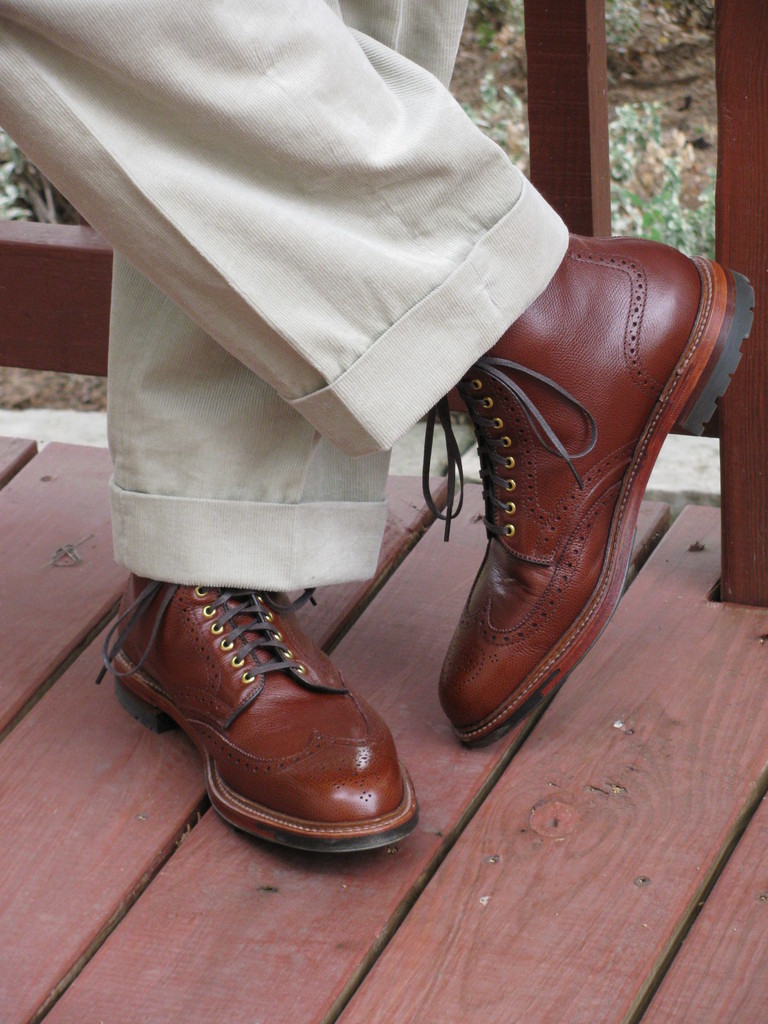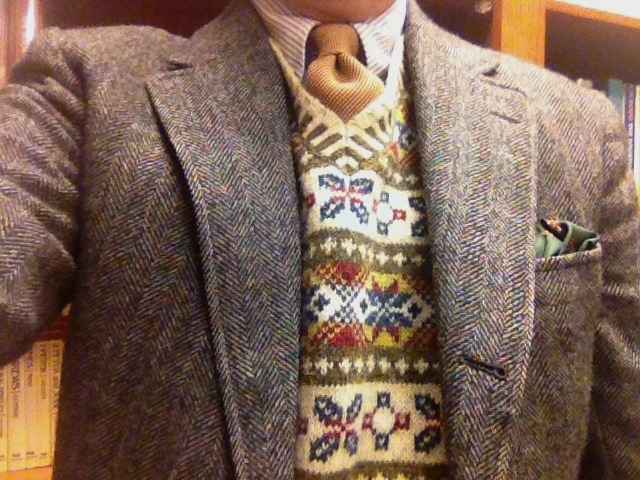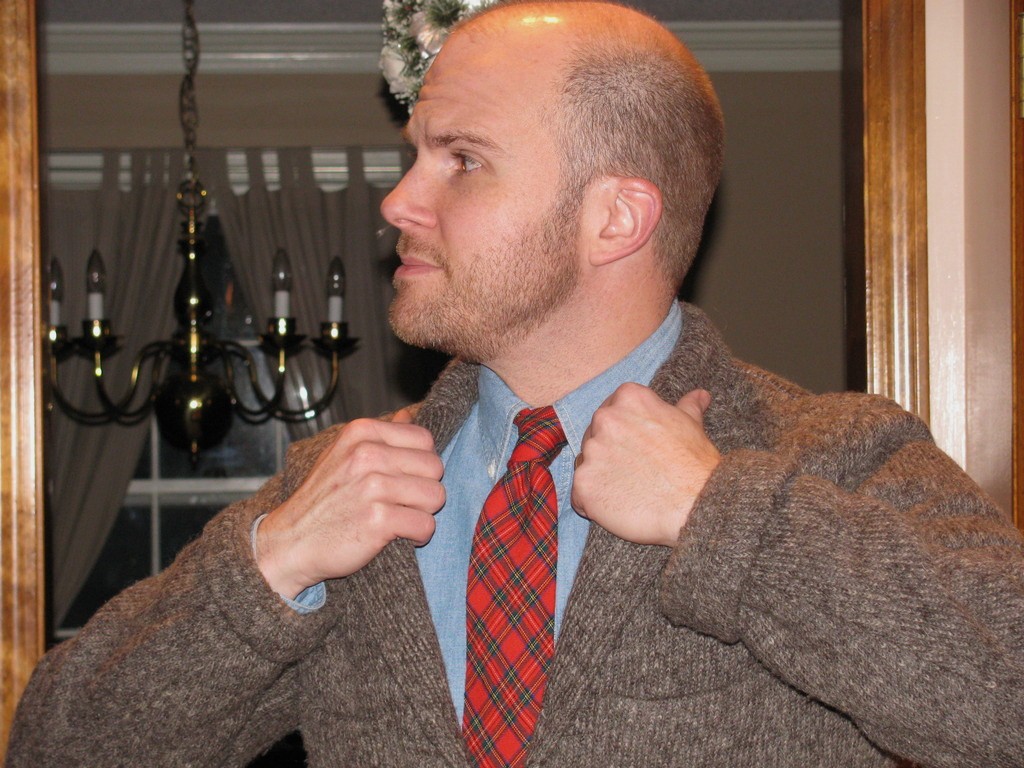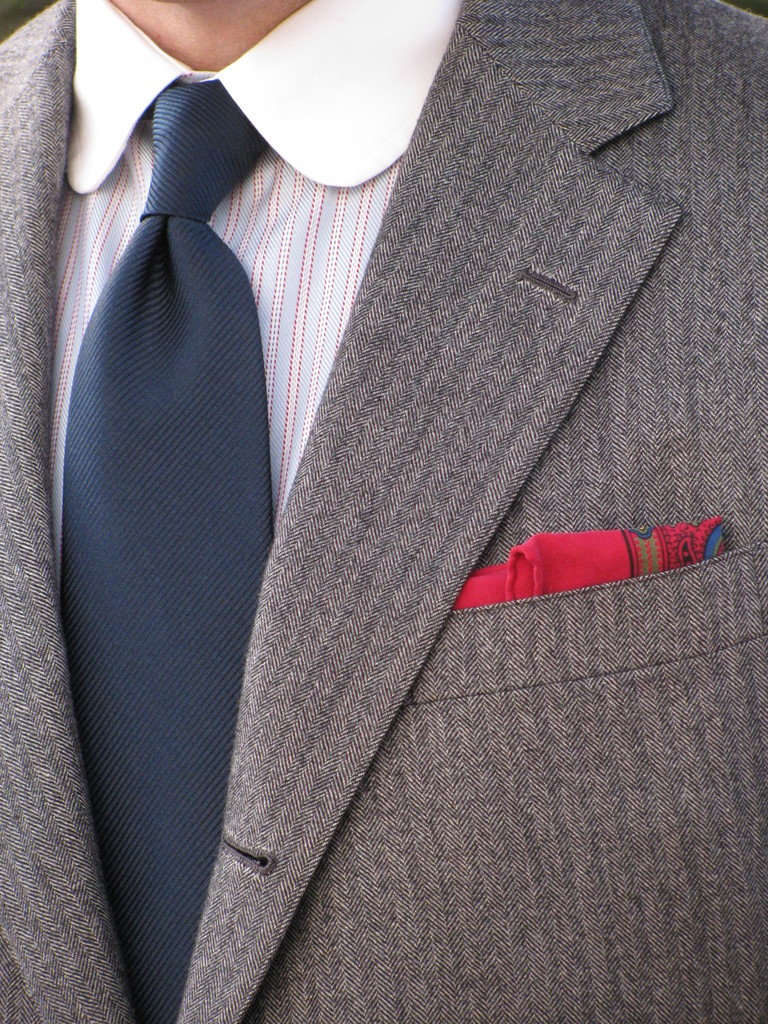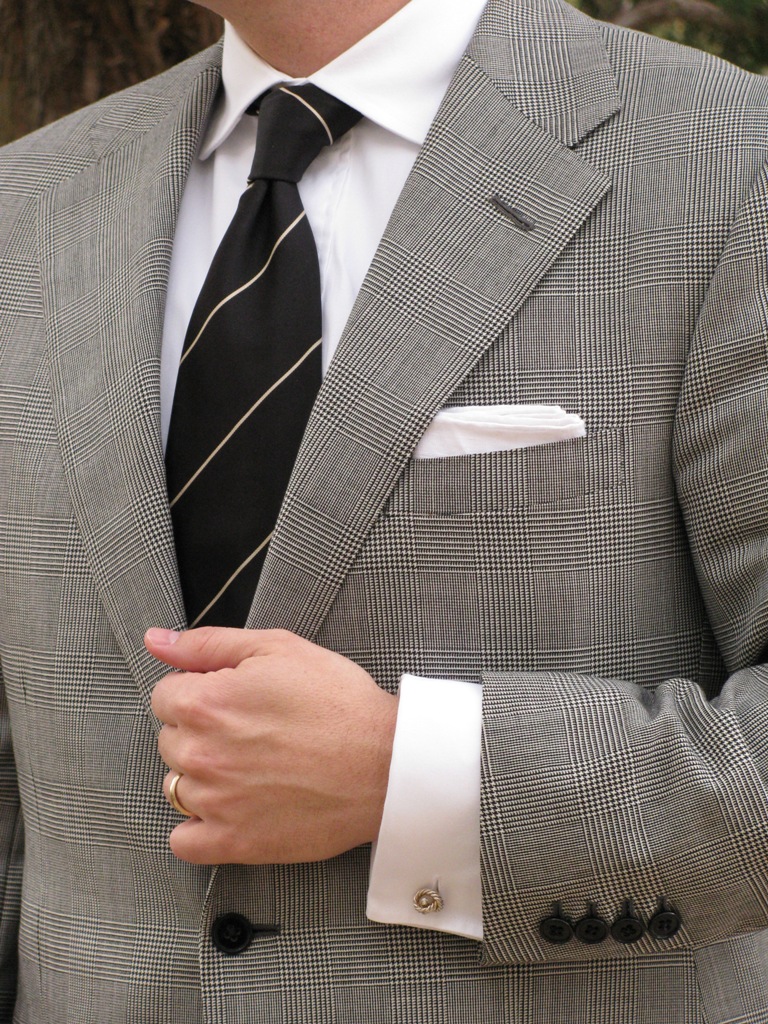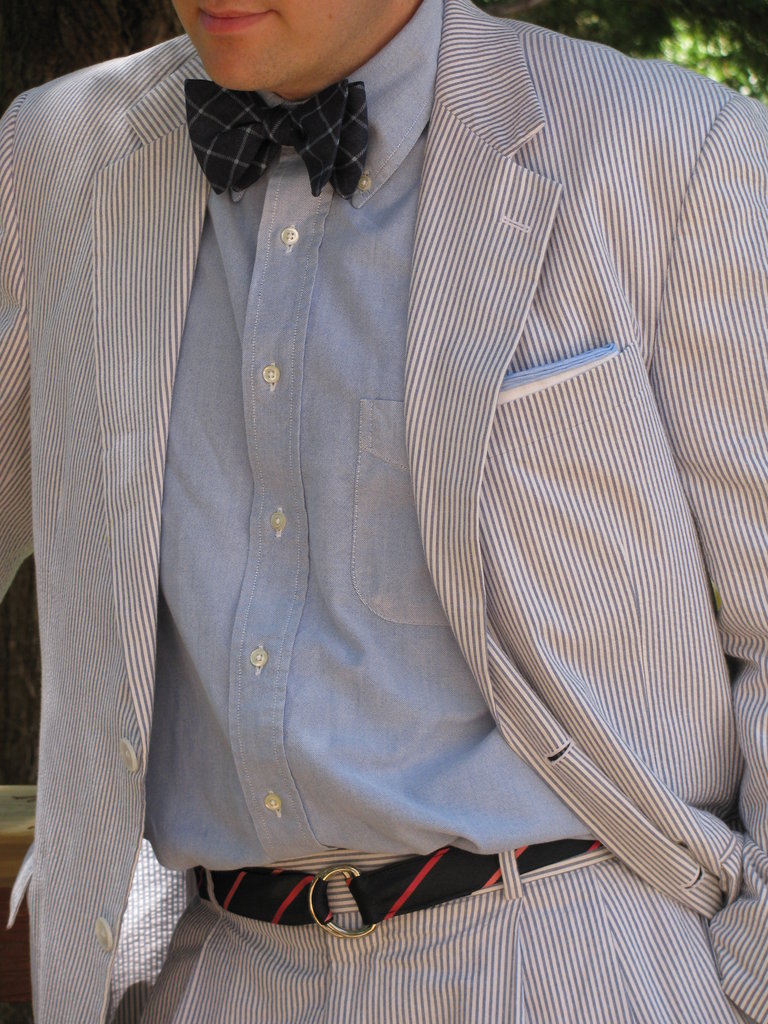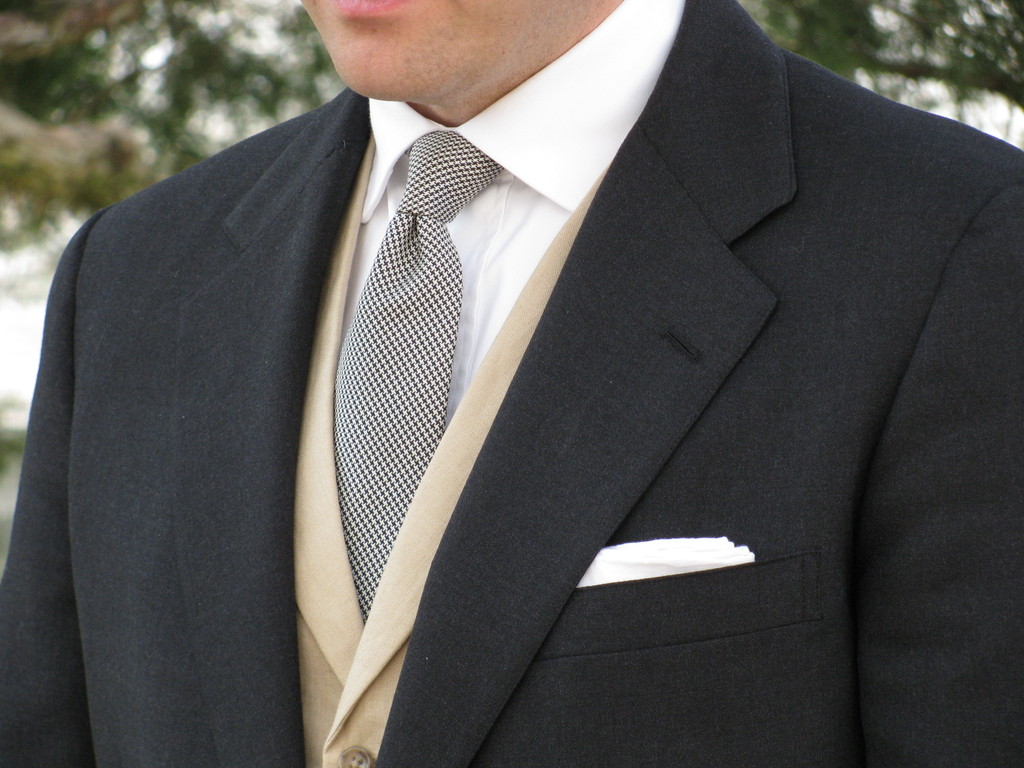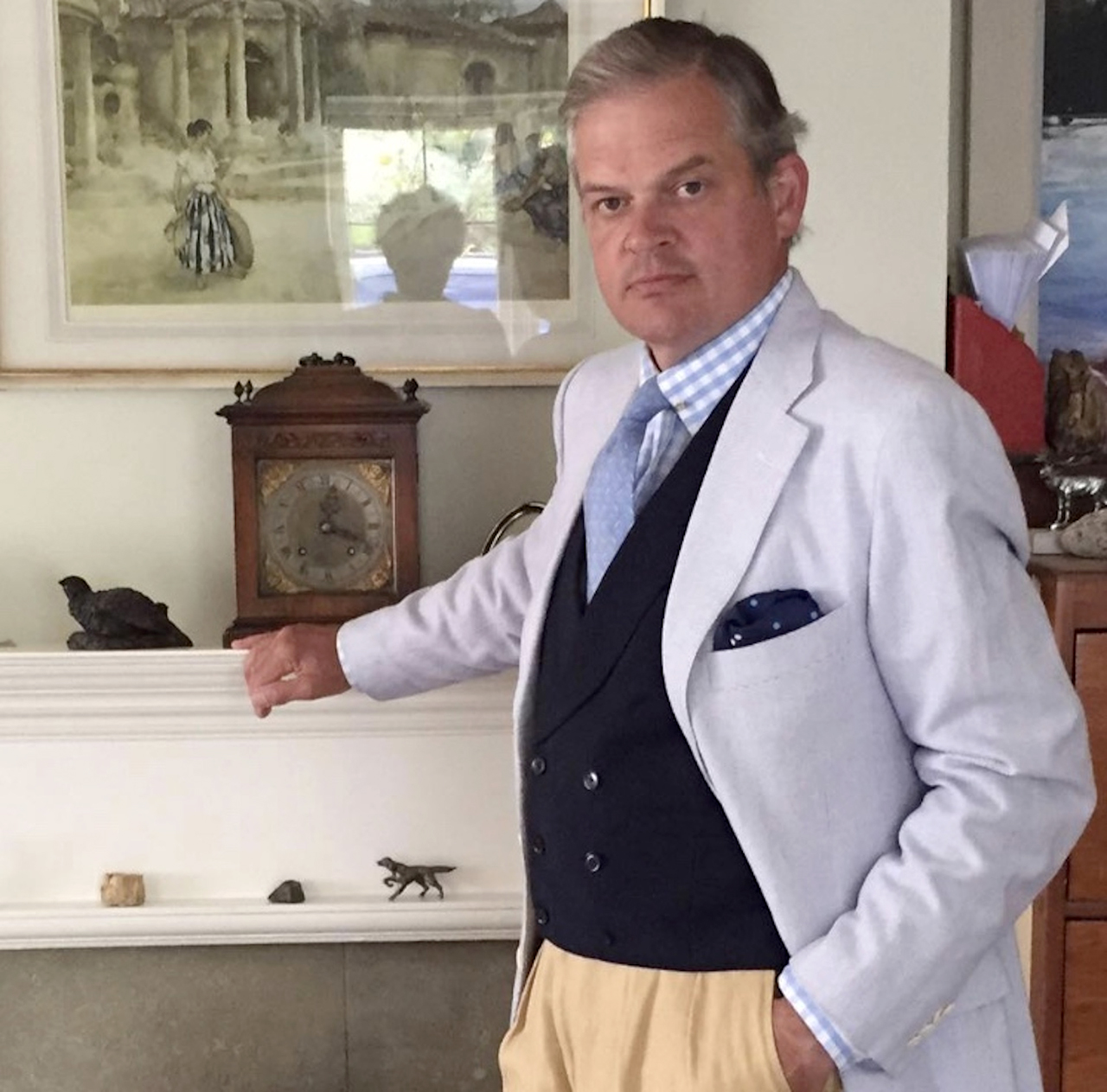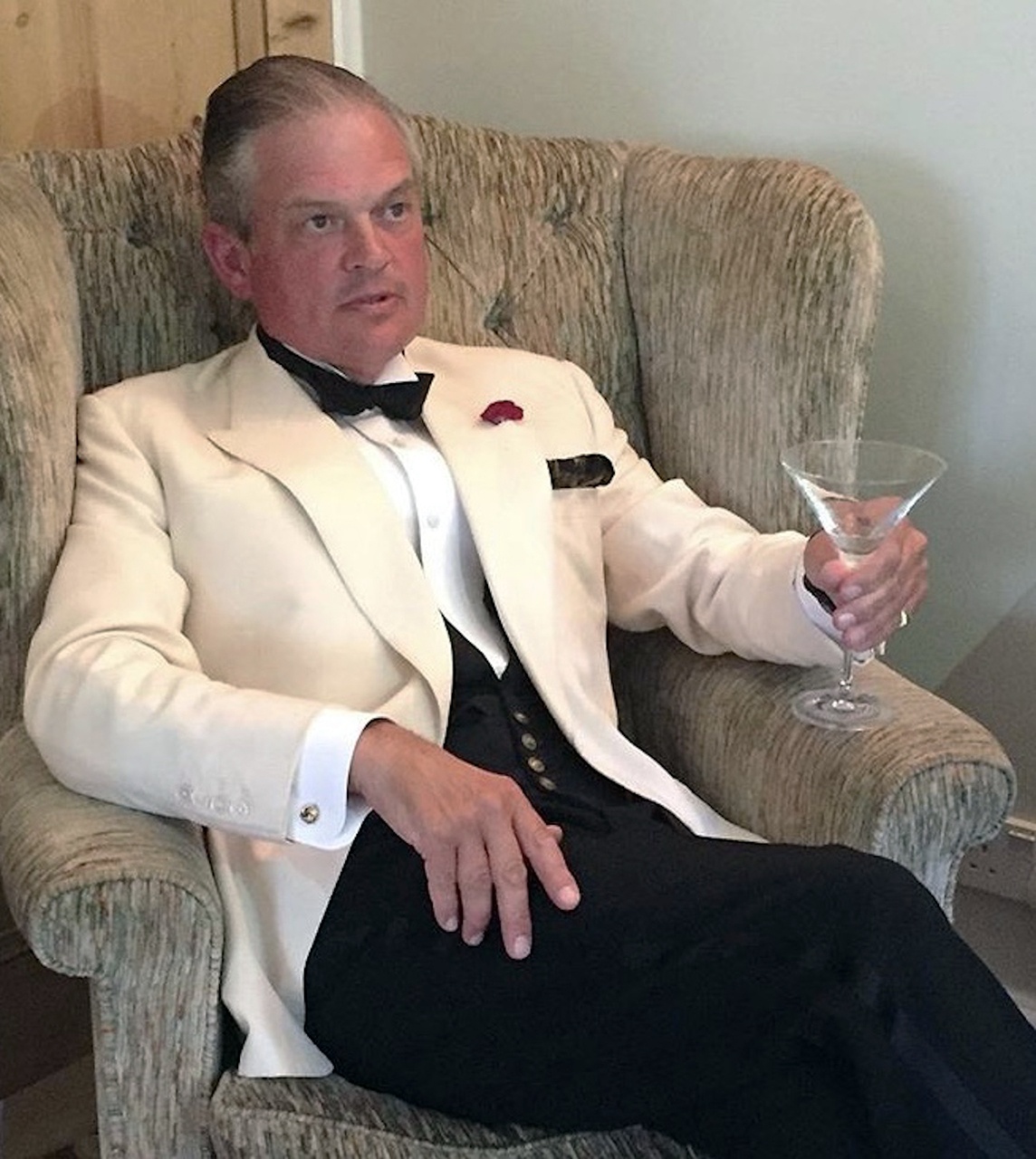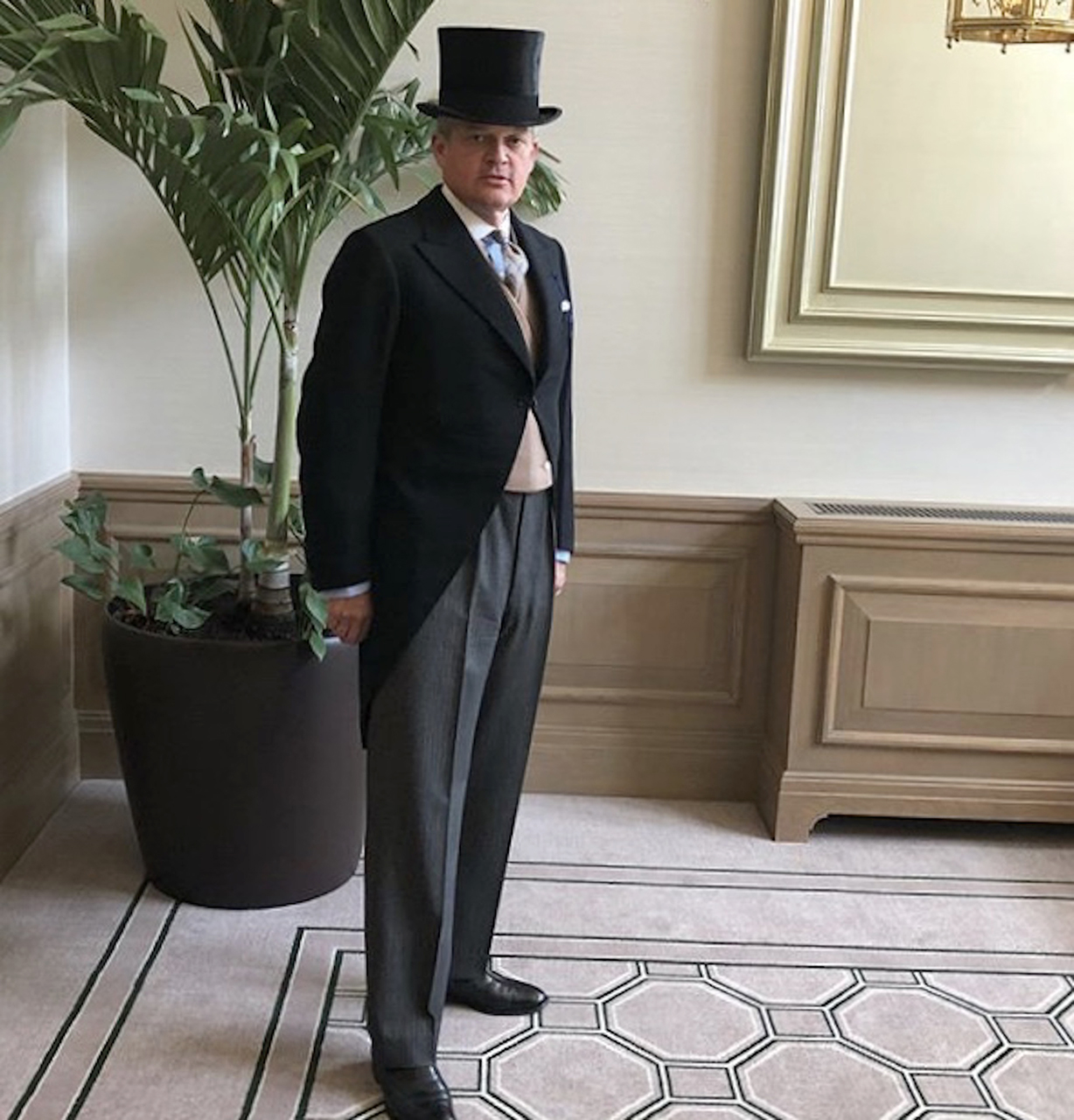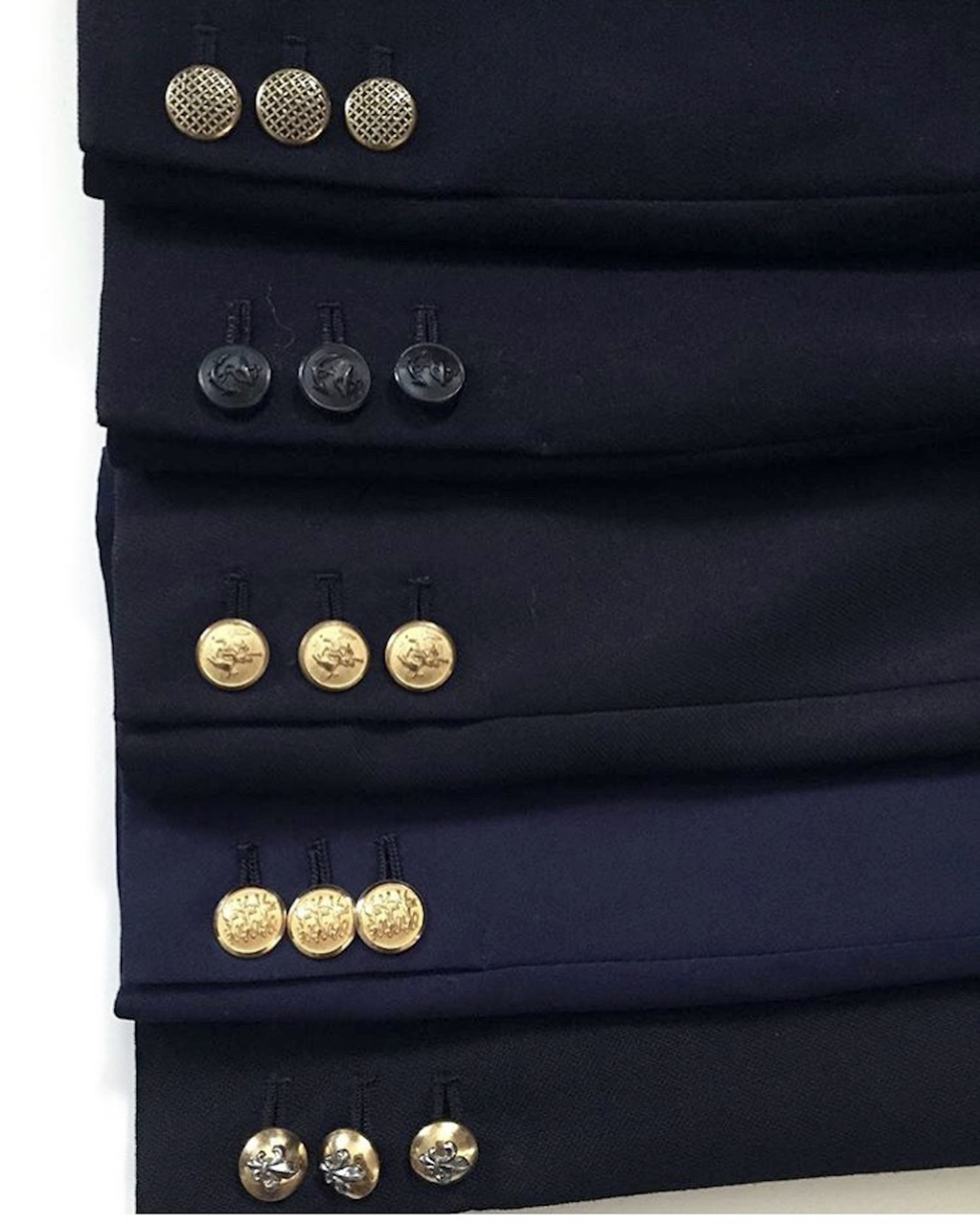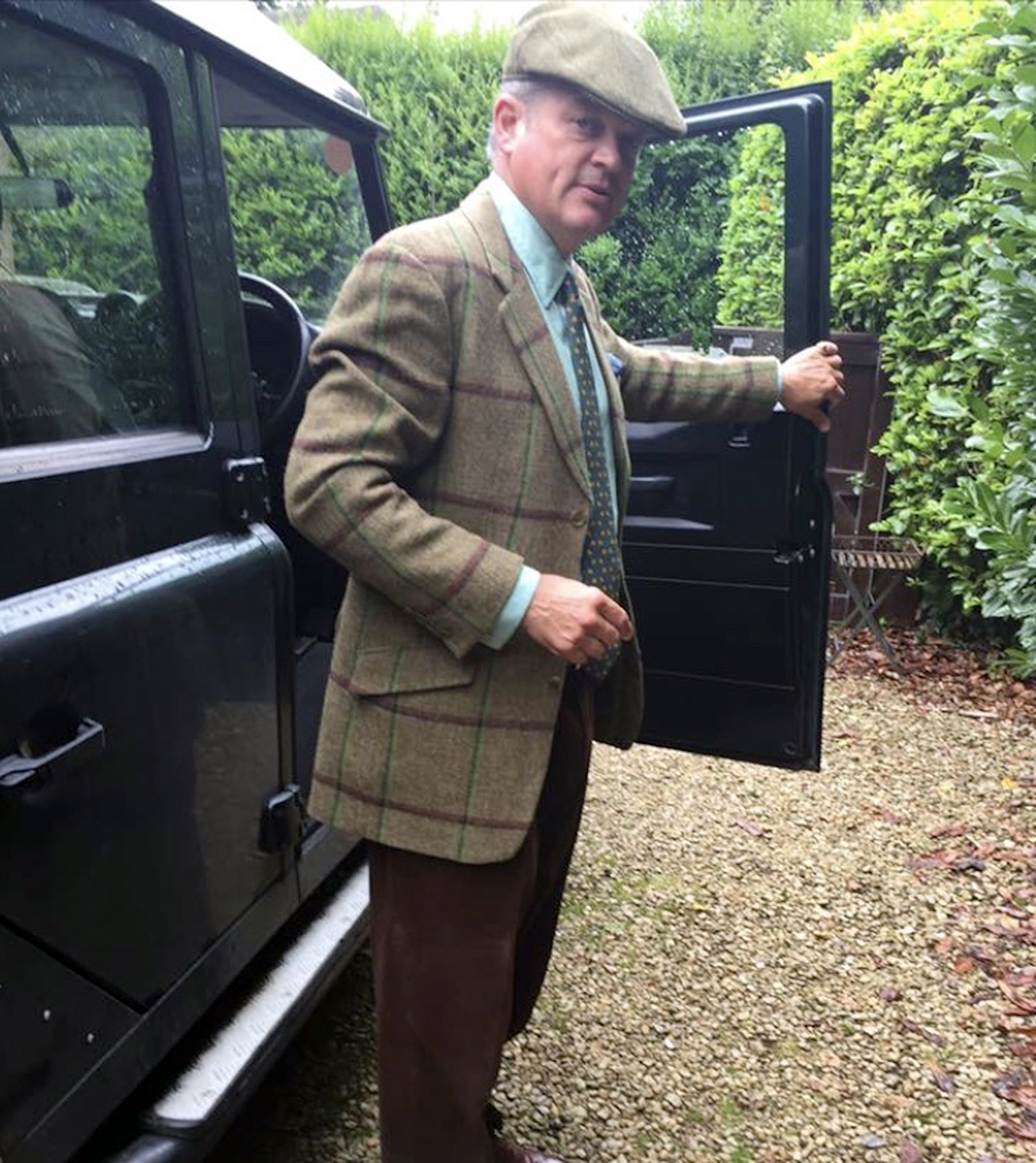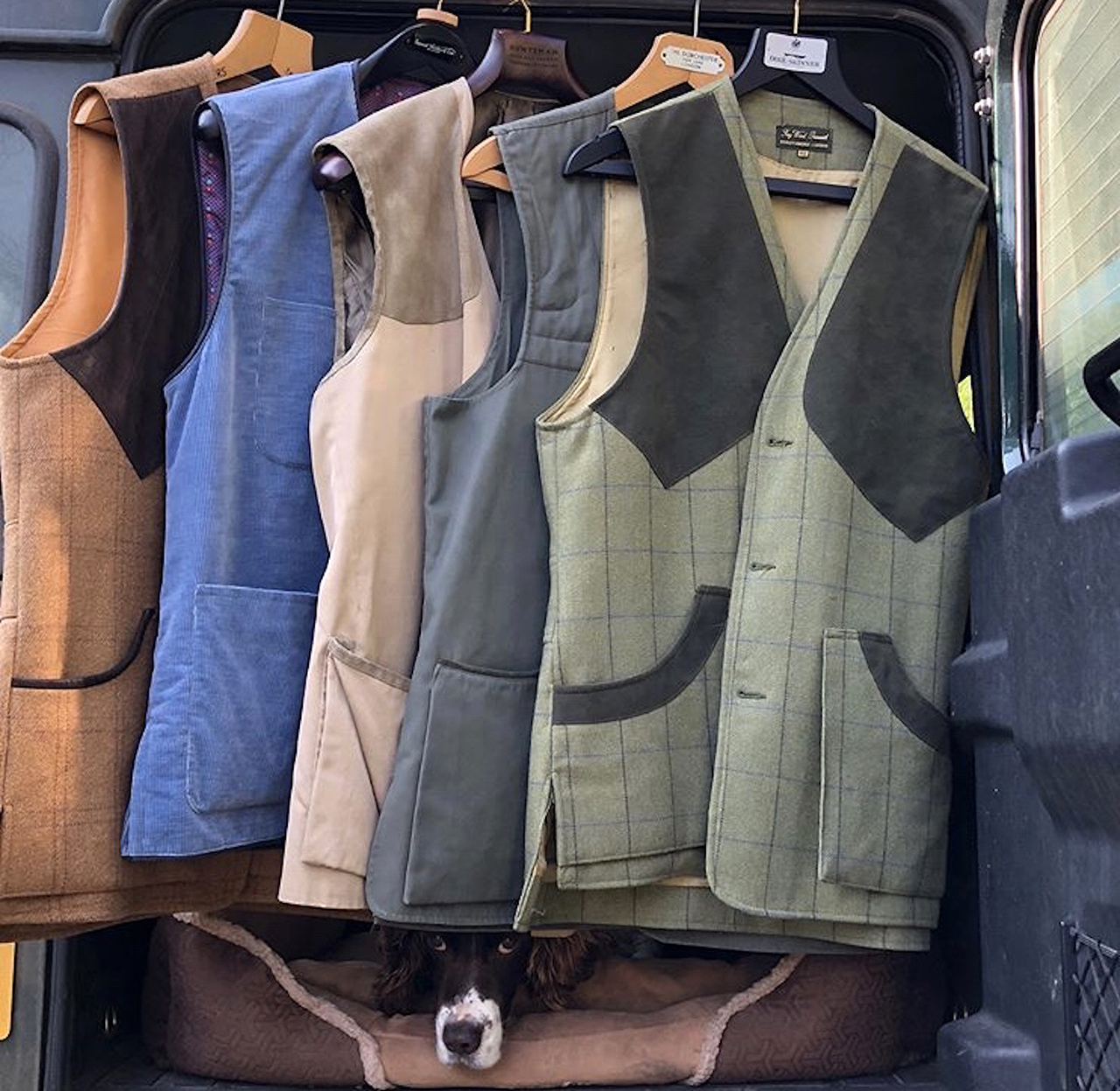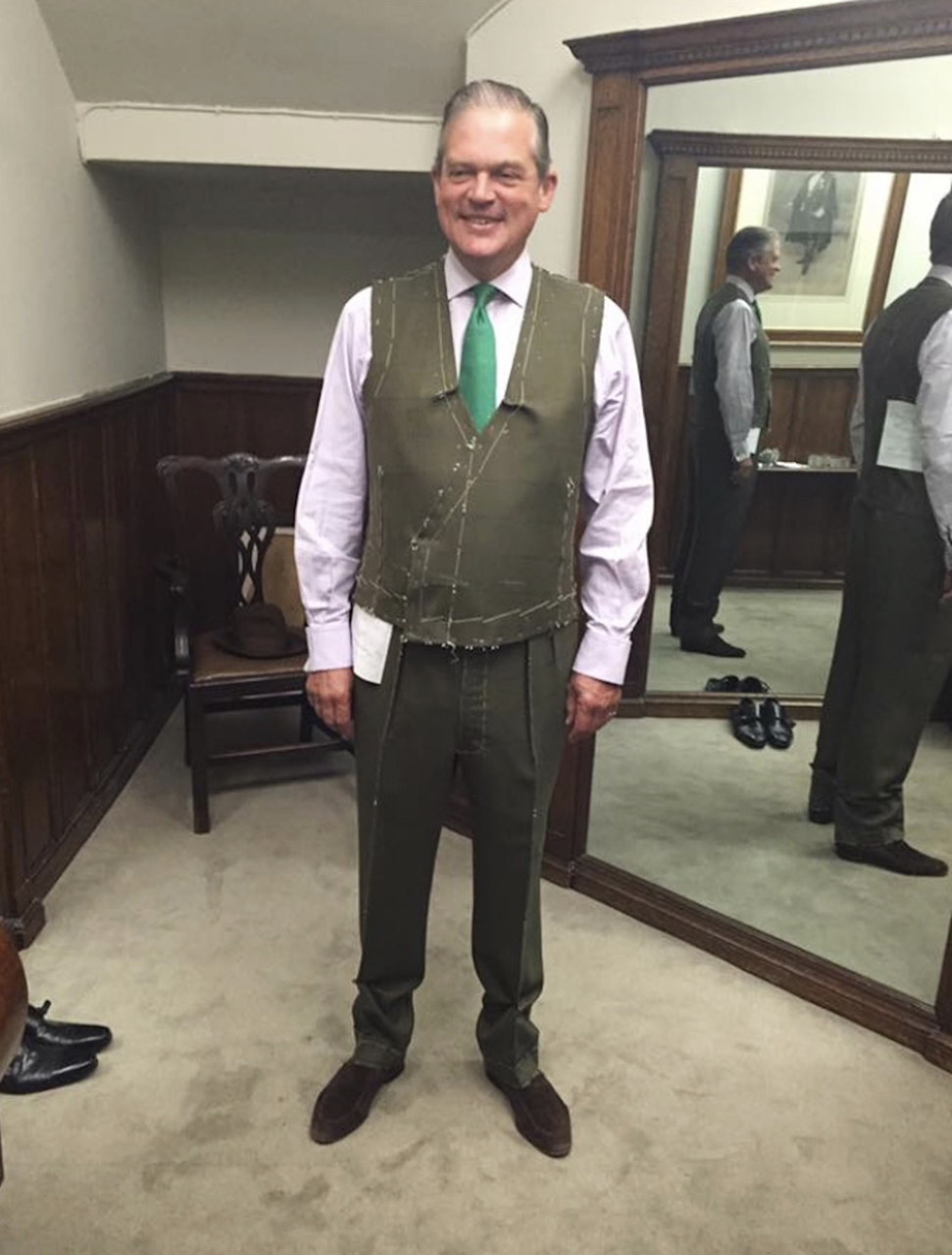-
Interview with Art Fawcett
4June 27, 2013 by Ville Raivio
‘I’m 63 and a hat maker. High school, 2 yr. college, 4 yr apprenticeship in Masonry. I have one son who is interested only in as much as I am so involved. My parents have passed but my siblings are very proud of my work and reputation. In the late 1980s I bought my first “old car,” a 1932 Buick and joined a touring auto club. As part of this experience, my then wife and I started researching the clothing of the era so that we could dress the part while driving ala, 1932 clothing in a 1932 auto. Things progressed quickly and in very short amount of time she had opened a vintage clothing shop in our home, then a store, then a bigger store, then our own building, it goes on and on. By the time we retired in 2005 we had built one of the largest and most respected clothing stores in California.
When in the vintage business, one is confronted with a decision fairly quickly as to the direction. There is always today’s “fad” or there classic lines and fabrics that are timeless. In the 1990s the Japanese buyers were paying up to $1K for a Hawaiian shirt so dealers scoured the earth to find them, only to discover the fad was over and they had inventory that was worth 1/3 of what they invested (at best). We decided early on that we must not chase the fad, but rather set the tone through classic lines and fabrics. Some things are timeless.
As part of that business, even though I was a full time Masonry Contractor in the San Francisco area, I started learning how to clean, reblock and enlarge old hats, making them either saleable for the store or rentable for the films (we were involved with over 150 films) by taking the old ones apart and trying to reverse engineer them. Learning materials are basically non-existent, so trial and error is the only way in most cases. Although there was a hat maker in San Francisco, he was extremely protective of knowledge and downright unfriendly to anyone he saw as a potential threat. In that process, I started collecting the equipment to make the job work, I still collect equipment, along with buying up all of the vintage ribbon I could find so that after years of collecting I had the appropriate ribbon (era) for the approx. year of the hat I was renovating. Trying to use a modern ribbon on a 60 yr old hat just didn’t look right to me and I assume it wouldn’t look right to everyone else.
My style is mostly vintage/classic. My favorite era for men’s clothing is the 1930’s with the hourglass tailoring, so I favor that look. Being thin, I’m able to find much of what I like. After retiring from the Construction and vintage world in 2005, I sold most of my clothing and moved to the mountains of Southern Oregon so my wardrobe is beginning to take shape again now that I have moved back into town. I have no favorite RTW designers but often like Lauren classics and Zegna designs. I am a builder, so I help with charities that build homes for the underprivileged in my area. I am learning to cook and really enjoy that also.
After retiring in 2005 we bought land and moved north. Once the initial building phase was done (we bought raw land, no roads, power, conveniences) I realized I still needed to earn the some monthly income because I was too young for Govt. pensions so we added a hat workshop to the buildings. I had been a member of The Fedora Lounge almost since its inception so I came to look at its members as “extended family”. When trying to decide how to make my hobby, hatting, a business, I decided to make only ten of any one design so that I never got bored, made up one design to show out of scraps I had in boxes in the shop, and posted it online in the Fedora Lounge. I honestly had no idea if there was a market for what I did and for my style of hat making, so when the first design sold out (all 10) in 36 hours I was stunned to say the least. I had my answer, I needed to get busy developing it from hobby to business in a hurry. After 7 yrs now, I finally feel that I have a handle on the industry and am about as prepared for the future as anyone can be. In the process, I believe I have become the most copied hatter in the industry via the color stripes my works are known for.
I make classic lines and styles, but with a twist. I always want people to notice the materials used in the hats I make (beaver, beaver blends) but what I hope for is what I call the “double take”. Have you ever noticed something or someone as you walked by them and realized something was different, but not flashy, so you had to look again? That is the “double take”. I try to make my work stand out but in a subtle way most of the time. I’m known for my “color stripe” in the knot of the ribbon, very thin, quite contrasting yet quite subtle. The angles of the bow tips, the shades of ribbon, the texture of the felt, the innovation of the ribbon design, all are trademarks of my work. I have been blessed with a client base that realizes I am an artist at heart and allow me the freedom to quite often design and innovate on hats commissioned by them. I have a client in Paris who loves to be the first in the world to own new designs, so often when I have an idea that I don’t know whether will work or not, it will be worked out and sent to this client to be introduced to the world. That gives me the freedom I need to explore and at the same time offers a certain pride of ownership for my clients. How could life be better? If I had to describe my work in one sentence I can do it in two words: Quiet elegance.
As a Bespoke hatter, it can only work one way. Once a decision is made to commission a hat, I send a package with a conformer and felt samples to my client. The client uses the conformer, tightens everything up, and sends it back to me. That way I have not only the client’s size, but head shape as well. Once the material colors and dimensions are discussed and agreed upon, often using pictures of the client to determine the best proportions for them, the hat is built to their head shape. I often also make what is called a “band block” of my client’s head shape and keep it in storage, so the second time the client orders from me, all that is needed is consent and details.
If you count western hatters, there are many more than a dozen true hatmakers in America. Why should one choose VS? Quality, pure and simple, and attention to details that make a difference. My grandmother always used to say “God is in the details,” but it took me until adulthood to understand that it’s the little things, like spending the extra time and money to get it right on the fit, to the extra expense to get the finest leather for sweatbands even though most wouldn’t know. Getting it right means taking the extra steps even and especially when nobody is looking.
Inspiration comes from everywhere. A few years ago I was asked to build a hat that would honor my client’s “Native American” heritage and it had me stumped for quite some time, until I realized the term didn’t only apply to the US and looked south. What I came up with was a ribbon design that assimilated the Mayan and Incan culture of pyramids and made the hat with tails at a 45 degree angle, resembling the step pyramids of Mexico and south. My client was so excited he named the hat “Pyramid of the Moon” and that began what I call my “Native“ phase in which I fold ribbons of different colors to form designs.
Last year I was in Los Angeles and was invited to a play in downtown LA. It was at a theatre that was part of a complex, and after the play my friend and I sat for a glass of wine and to talk when suddenly water sprang from seemingly everywhere, coming from a water feature built into the concrete and shooting it in the air at different pressures creating not only city light reflections through the walls of water, but doing it at different heights. It was marvelous and I immediately started seeing a hat in my mind’s eye that would later become a one of a kind hat, owned by my friend, we named the “Chandler” after the Dorothy Chandler Pavilion in LA.
My favorite designer of all time is actually an automobile designer named Alexis De Sahknoffsky. He designed the Auburn, Cord (I think), countless designs using the streamline as a basis. He designed streamlined trains, boat tail cars, simply ahead of his time. If you study my hats you will see a lower, sleeker, longer feel to them than others. Style is the creation of a positive image rooted in the idea that beauty is in the eye of the beholder.
There are basic rules for fitting hats to face shapes that are covered in many places on the internet, so please start there. Once a basic specification (brim width, etc.) is determined from what you read, then start building hats a little taller or the brim wider than recommended to get a feel for it. You can always crease (bash) the hat lower or cut the brim shorter, but you will at least start with many options. The right specs will come about much like picking a tie for your suit. Once you put the suit on the bed and start putting neckties on it to see the effect, the right one always appears.
Please understand that I grew up wearing hats, so it seems and feels natural to me under all conditions. The expression goes, “wear the hat, don’t let it wear you”, but what that means is “be brave and confident“ and that is what people will see, the confidence, not the hat. As a small man in stature, I grew up always being the smallest in the crowd and developed a sense of dread when in crowds or especially walking into restaurants. I felt that everyone was looking at me and it was very intimidating. In my early 20s I experienced some success in my career and was respected as such but couldn’t get past that fear walking into the diner, so I made up my mind to first hold my head up, throw my shoulders back and straight, and tell myself just before going in that “I OWN this place”. The first few times I did so, it felt very awkward but funny enough, after only a few times I was receiving more respectful greetings from those employed to do so, getting better table placements and friendlier-than-expected service. Why? I think because my attitude told them that I expected that kind of treatment and respect, so that’s what I received. Please bear in mind, though, I did not make demands, was not loud in any way, I simply assumed and expected good service and almost every time received just that.
The first time you go out in public with a hat on, hold your head up, throw your shoulders back, and KNOW that you OWN this. Others will know it also.’
http://www.vintagesilhouettes.com/
Pictures: © Art Fawcett
Category Hat-makers, Hats and Caps, Interviews, Quality makers | Tags:
-
Interview with Alan Cornett
1May 30, 2013 by Ville Raivio
‘I am 43 and work as an evangelist. I have degrees in history from the University of Kentucky and the University of South Carolina. I’ve been married to my lovely wife Traci for 18 years. We have three daughters, ages 13, 10 and 7. They are generally tolerant to supportive. One of my sisters doesn’t like bow ties, so I try to wear them around her as much as possible. My mother fears that any true luxury item, even when thrifted or purchased at steep discount, is “too nice.” I’m sure Paul Fussell would have a field day with that. I first became interested in clothes during high school, but I had no real direction. As with most teenagers there was quite a bit of fashion, virtually all of it bad. This was pre-Internet so I had no access to any good information.
By inclination I have an appreciation for the classic. I’m innately conservative, well, reactionary, in most everything. Ask yourself, how embarrassed will I be in twenty or thirty years to see myself in a picture wearing this? I hope that in twenty or thirty years I’m still wearing many of the same clothes I wear now. The turning point for me was finding a copy of Bruce Boyer’s book Elegance on remainder at a local bookshop when I was in college. I had never heard of Boyer, but I inhaled the book, reading and re-reading it. I happened to be studying abroad in England that summer so I packed the Boyer and took it with me. I walked Jermyn Street and Savile Row. I purchased some ties at Gieves & Hawkes that I still own, and my first bow tie at Harrod’s, which I wore out.
A fellow summer student at Oxford who was from Yale taught me how to tie the bow tie. He was having a bespoke sportcoat made on the Row that summer. I was very jealous, of course, but that was far outside of anything I could afford. I also purchased an umbrella from James Smith & Sons, a shop Boyer featured in Elegance. Again, this was in the early ‘90s, before Internet shopping. Boyer had a list of mail order companies so I started sending off for catalogs. I ordered my first Brooks Brothers oxford button-downs, and I’ve been wearing those ever since. I began dressing in more of a classic Ivy way, although without any real self-consciousness of Ivy qua Ivy. Still, there was a limit to how far I could take things with the income of a student then later as a minister. It wasn’t until I found the clothing forums in 2003 that I could really put everything together.
I did a search for some now forgotten, and I’m sure mundane, clothing topic a decade ago. I stumbled across AAAC and was floored by the depth of knowledge. There was only the main forum then. I read my way back through it. This was what I consider the Golden Age when a lot of knowledgeable members who no longer post were there. It was before the forums sank into irony, cynicism, and snark. The forums, AAAC and SF, as well as The Fedora Lounge, were all very good to me. I learned a great deal. I don’t post much on any of them these days. I do my own blogging and follow some things on Twitter, but I have other things going on that take up my time. A lot of the same things are, of necessity, rehashed on the forums. There are only so many times you want to discuss the same topic. I think they can be a great starting point for someone wanting to learn.
[My style is] traditionally eclectic. While I am probably most identified with “Trad,” my actual dress transcends that. I have a strong streak of Anglophilia, but also enjoy quality offerings from the Italians. The best Italian stuff is really Anglophile in its roots. What allowed me to dress as I do on my (limited) budget was hitting thrift and consignment stores, the forum buying and selling sections, and sales. That approach of necessity forces one into what’s available rather than what might be one’s absolute favorite. It’s a slow process, but after a decade I have too much, really. I was also given a huge boost to my wardrobe by the generosity of my good friend and forum legend Kenneth C. Pollock of Atlanta. His taste is impeccable.
At the core of what I have is Brooks Brothers, Oxxford, and Ralph Lauren, both Polo and Purple Label. Because I was in Kansas City for several years, I ended up with quite a bit from Venanzi, a high-end shop in New York City. Venanzi went out of business, and Rick’s of Kansas City purchased their liquidated merchandise. It’s all extremely high quality from the best Italian and British makers. I also enjoy the vintage Norman Hilton pieces I have. My favorite dress shirts are from Guy Rover and Charvet. I have quite a few Nicky ties. I also love Drake’s.
With shoes I have more from Alden than anything else. My pride and joy are a pair of brogue boots from Leather Soul Hawaii that were made based on my design. Leather Soul had a shoe design contest. I was blessed to have won. I have some Edward Green, Crockett & Jones, and a pair of Grenson Masterpiece from the legendary Bennie’s sale. I also own several pairs from the now-defunct, but wonderful vintage maker, Nettleton. One of my most worn pairs are a casual ranger moccasins from Rancourt of Maine I had made last year.
I have particular weaknesses for outerwear, cufflinks, and briefcases. I’ve tried to limit those as much as I can. Most of what I have are vintage (used/vintage outerwear can be a steal on eBay), and include a vintage camel hair polo coat, a J. Press Chesterfield from the 1930s, a Gieves & Hawkes double-breasted Chesterfield, a couple of Barbours. Likewise my cufflinks are mostly vintage, double-sided links from the art deco era. I have several pairs of lovely Belais links. The modern pair I prize are sterling knots from Hermes. I sold off some extra links I had to fund them a few years back.
I’ve picked up various briefcases over the years, but my go-to bags are a Filson 257 and an English bridle leather bag from R.F. Clark Saddlery. Clark was a discovery by my friend J. Mark Bertrand. He worked at Swaine Adeney for years and now has his own shop. You can find him at Etsy. I like to wear hats. My favorite is a vintage Disney from the 1940s that I found in a thrift shop in Chattanooga. Art Fawcett refurbished it for me. Art has made custom hats for me, both felt and Panamas. I have some Borsalinos plus other odds and ends.
After all this time I’m still loyal to the one who started it all for me: G. Bruce Boyer. He really embodies the kind of relaxed, comfortable style I aspire to. Just take the first dozen or so Google images for Boyer and that’s about all the style direction you need. The old Fellows Apparel Arts/Esky images are a perpetual source of inspiration and guidance. Luciano Barbera is another wonderful exemplar, and, to me, embodies a similar approach to Boyer. None of this is original, but originality in dress is usually overrated. I really enjoy voxsartoria’s stream of images on his blog/Twitter, and of all the #menswear personalities, he dresses how I would if I had his disposable income. My old forum friend RJ does nice work over at A Suitable Wardrobe. He and I share an interest in sartorial obscurata and little known super villains. Our dressing styles are not the same, but his taste is always spot on.
I think style is presenting yourself tastefully and comfortably. Modern dress embraces comfort, or perceived comfort, to the exclusion of anything else. We live in a more casual time, and there’s no chance of completely reversing that. We have to find ways of navigating declining formality while maintain good taste. We can also make strides in reviving classic styles without appearing anachronistic or costumey. As a Christian I spend a lot of time with my church. My wife and girls have a great deal of my attention, of course. I have an interest in books and reading, particularly Southern (American) literature. I do a little collecting of first editions. I enjoy college basketball and (American) football. I have a great appreciation for Bluegrass music, and am a bit of a failed mandolinist. I enjoy food, particularly barbeque, and sampling barbeque from as many dives and vendors as I can.
Well, believe me I was not born with rakish relatives. I would say start slow, make incremental changes with quality purchases. Upgrading to top quality ties is an easy change to make, but can have a profound impact. Add in linen pocket square. Buy a pair of Goodyear-welted shoes and take care of them. It can be intimidating and overwhelming when you see fit pics of men with bespoke everything when you know that’s out of reach for you. Hand in hand with this is the development of good taste. First, one must accept that there is such a thing, then you have to train your eye and your preferences. This isn’t the same thing as buying into group think, but imitation of exemplars is the place to start.’
Pictures: © Alan Cornett
Category AAAC, Bloggers, Interviews, Men of style, Styleforum | Tags:
-
An Interview with Paul Farrant
2January 30, 2019 by Ville Raivio
VR: Your age and occupation ?
PF: 56, Property Manager.
Summer gear
VR: Your educational background?
PF: I attended St. Chris in Letchworth, Hertfordshire. A forward-thinking, co-educational, vegetarian boarding school. After a short spell working for my grandfather’s engineering company I was fortunate enough to be offered a position, aged 20, at the Dorchester Hotel in London.
VR: Have you any children or spouse (and how do they relate to your style enthusiasm)?
PF: Yes, I am married to Jackie and we have two teenage children. Olivia & George. I think it would be fair to comment that they tolerate my vintage clothing obsession. There are advantages as the 3 of them have all benefited from some special pieces. As I am in contact with a lot of the dealers I come across women’s items as well as men’s. Jackie has some vintage Huntsman, Henry Poole, Dege and Skinner and numerous furs.
Recently I was walking along Jermyn Street with Olivia & George. I had a Gelot fedora on. George a beanie hat. Someone stopped us and advised George that he should take some style advice from his father. As can be imagined, George has not taken up the advice of the passerby.
A summer party look
VR: …and your parents and siblings’ reactions back when you were younger?
I owe a lot to my mother. She has to take credit for being such a fine role model. Now in her 70s, she is still most elegant. My grandfather spent a lot of attention on his clothes too. His tailor was Airey & Wheeler in Piccadilly.
A 1938 Huntsman morning suit, Lock silk topper
VR: What other hobbies or passions do you have besides apparel?
PF: I enjoy fishing with George. I manage to include some vintage equipment especially when fly fishing. Sometimes using vintage is a big disadvantage, though. Last year I snapped a rod and lines, as lures and nets weaken over time.
My love of good food and fine dining has led to my collection of vintage menus. Although I have stopped adding to this. They are starting to be included on one of three of my Instagram accounts, vintage_menus.
I am very pedantic about quality of ingredients and presentation. After my early years at the Dorchester I worked for the Royal Household. My position here was involved with food supplies, presentation, menus and seating planning.
My other Instagram account is vintage_clothing_labels. On this account I post interesting labels of vintage pieces of mine and others, such as Hornets and Hogspear.
I used to horse ride a lot, but don’t get the opportunity so much now. I have kept my riding ‘kit’.1957 Lobb’s boots and 1947 Huntsman riding breeches. I recently sold my hunting pink swallow tails made by French C1900 of Kilgour, French & Stanbury to an American collector.
City blazers
VR: How did you first become interested in style, and when did you first turn your eyes to the classics?
PF: I have enjoyed a more formal and classic style from as early as around 10 years old. My mother reminded me, over the recent Christmas holiday, how she bought me a Harry Hall tweed hacking jacket when I was 11. Apparently I wouldn’t take it off and paraded around like a peacock.
My first job at the Dorchester Hotel continued with the formal dress theme. In the front office, in those days, we wore full morning dress during the day. This was with starched detachable collars too. During the evenings we changed into black tie.
During my time at Buckingham Palace we wore morning dress for the day and white tie in the evening during State visits.
I have always preferred a more structured cut, such as Huntsman. While I can see the benefits of a more softer cut, giving ease of movement, such as Anderson & Sheppard, they don’t suit my shape as well.
A country look
VR: How have you gathered your knowledge of the vintage look — from books, talks with salesmen or somewhere else?
PF: I suppose the largest influence during my earlier years was regularly trawling through charity shops. 30 plus years ago, before access to the Internet, one could pick up some treasures at very reasonable prices. This has very much changed. The quality pieces do not come through and prices are higher. Though there are still bargains to be found. It’s just harder and more time consuming. My ‘strike rate’ is rapidly decreasing over the years.
On the plus side we now have eBay. I check this every day. John Morgan of Hogspear has to be a favourite. He still manages to locate some goodies from private house sales.
My friends at Hornets in Kensington are valuable for an opinion. Bill Wilde has a wealth of knowledge and we frequently chat over a glass or two in the local pub.
During my working life I have been fortunate enough to work with two royal valets. Sydney Johnson was valet to the Duke of Windsor. I knew Sydney from my Dorchester days when he was then valet to the Sultan of Brunei. During my time travelling with the Court I met Michael Fawcett. Then valet to the Prince of Wales. Michael would give me lessons on various aspects of maintaining a wardrobe and dress style. At Sandringham, one Christmas, we painstakingly went through all the various ways of presenting a pochette in the top pocket of a coat. Note coat, not jacket. Potatoes have jackets!
And of course Billy Tallon was often present at our gatherings. Backstairs Billy as he was known. Page to HM the Queen Mother. A most diverting character.
VR: How would you describe your personal style?
PF: I am neither a follower of past fashion or future fashion. Just somewhere in between.
Shooting gilets with a spaniel accessory
VR: Among so many companies you’ve tried, which artisans or RTW do you favour and why these?
PF: My collection now has been honed to such an extent that I now have mostly Savile Row pieces. About 30 lounge suits. During my 20s I favoured Hackett and Chester Barrie. Hackett I have a great fondness towards as I bought from them in New Kings Road in the mid ’80s. Chester Barrie offered great quality and their 40 reg fitted me like a glove. They made for Turnbull & Asser and Huntsman too. Two of my preferred outfitters. Oliver Brown and Herbie Frogg were RTW favourites too. Simpson’s always for cashmere jumpers. Tremendous quality and value in the seasonal sales.
For suits and topcoats I prefer Huntsman & Sons and Dege & Skinner. There are others on the Row as equally as good, but these two I have had an acquaintance with for many years.
At Huntsman
VR: Have you any particular style or cut philosophy behind the clothes you collect and wear?
PF: I am fairly open on all styles other than the Italian cut. It does not do for me at all. Too heavy on the shoulder and square. I prefer a double vent, too, on a coat. When wearing a suit I usually wear braces. Always when wearing a vest. There’s nothing worse than seeing a gap (usually with a bit of shirt fabric) between the top of the trousers and the bottom of a vest (waistcoat). The other ‘no, no’ is wearing a belt and braces. Hard to believe, but I have seen it!
All in all I subscribe to the best quality fabrics and workmanship in a classic Savile Row style.
Other than Purdey, Ray Ward and Holland & Holland I am beyond designer names. I have given my Gucci and Hermes belts etc., to my teenage children. They seem to enjoy wearing Purdey and Holland & Holland too. George has all my Ralph Lauren Purple Label now.
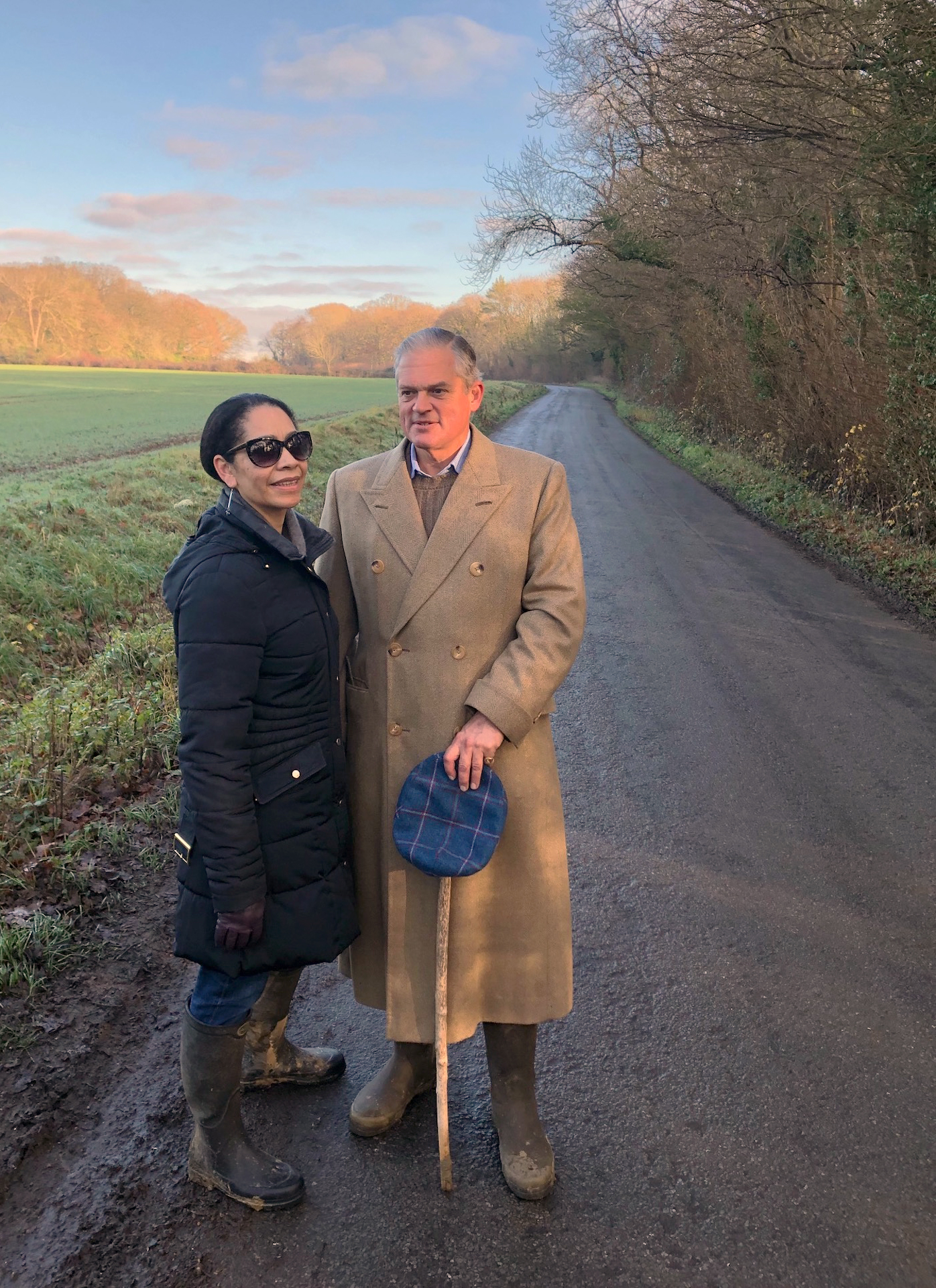 A Jones, Chalk & Dawson top coat with cuffed sleeves, Huntsman house tweed cap
A Jones, Chalk & Dawson top coat with cuffed sleeves, Huntsman house tweed capVR: Who or what inspires you?
PF: This is pretty straightforward to answer. Who would be The Duke of Windsor. Ahead of his time in many respects. What would be craftsmanship and fabric quality. Vicuña being the king of fabrics. For tweed it has to be the Islay Woollen Mill.
VR: What’s your definition of style?
PF: I think I have to borrow a quote from Hardy Amies on this. It is something I try and adhere to. A man should look as if he has bought his clothes with intelligence, put them on with care and then forgotten all about them.
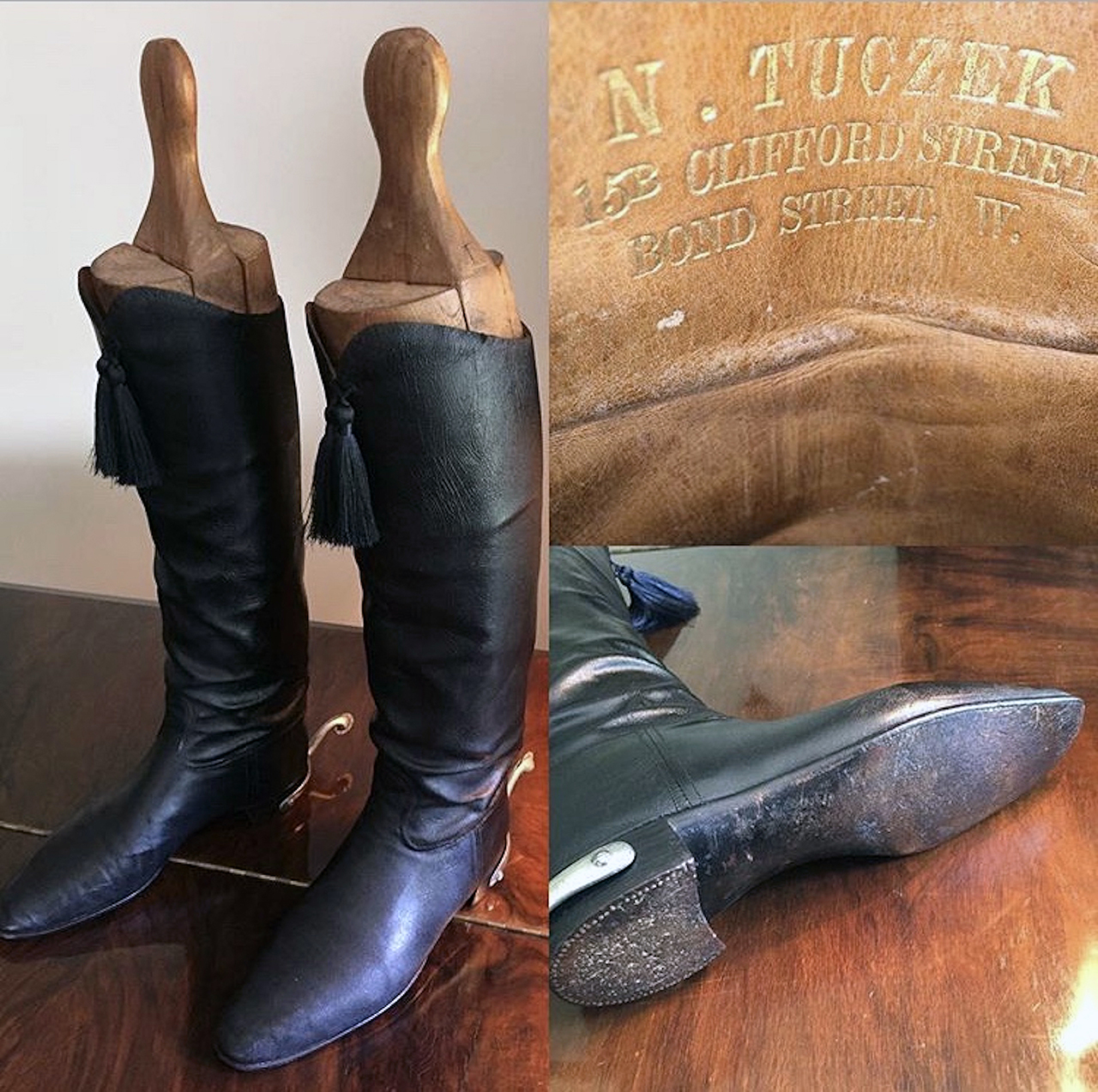 Hessian cavalry boots by Nikolaus Tuczek
Hessian cavalry boots by Nikolaus TuczekVR: Finally, given your knowledge on the subject why should Keikari’s readers consider vintage tailoring?
PF: At the end of the day it’s each man, or woman, for their own. What goes around comes around. I’ve seen some big named hitters buying vintage to replicate or at least for ideas. As the great YSL put it ‘ fashions fade, style is eternal’.
Category Interviews, Men of style, Vintage | Tags:

Keikari.com
On classic men's style, elegance, and the beautiful life.
